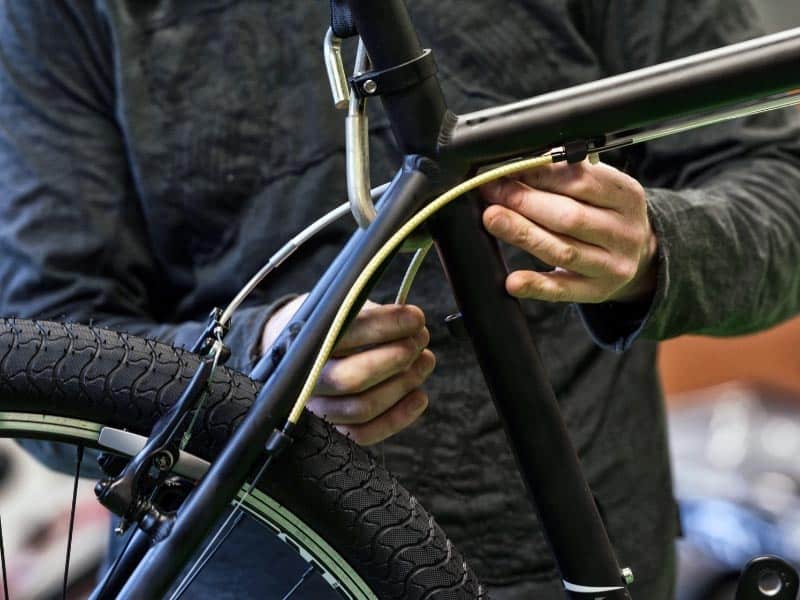As you cycle along the path or trail, the last thing you should be thinking is why are my bicycle brakes sticking? Sometimes brakes can get stuck and knowing what the cause is can get you back on the road much quicker.
To get the best performance from your bicycle, every component needs to be in working order. If something doesn’t feel right, you may need to check the brakes.
Sticking brakes can be a nuisance as well as a hazard. Bicycle brakes stick due to poor spring tension and resistance with the brake lever, worn brake pads, old or stiff brake cable housing, jammed or dirty caliper pivots, or a kinked brake cable.
Through research and personal experience, I have put together a list of the top reasons why your bicycle brakes are sticking. There can be a number of different causes, so it helps to know what to look for.
I recommend checking the top reasons discussed in this article to discover the source of your sticky brakes. Then, you can get your brakes fixed and hit the road.
Recommended Gear
To see all of my up-to-date recommendations for bikes and cycling gear, check out this resource that I made for you!
Table of Contents
Brake Lever
The bike levers are small metal levers mounted to the handlebars. They are what you pull when you want to put the brakes on. If you feel your brakes sticking, the problem could be with the levers.
If the brake lever is the issue, tension and resistance are the problems. If the lever feels loose and floppy when you release it, you need to take a closer look.
This is because the bike lever relies on the tension of the cable that attaches to the caliper. If any resistance is present, the lever will not spring back as it should. This causes the brakes to stick.
The most common causes of resistance to the brake levers include:
- Dirty brake lever
- Kinked or dirty housing
- Worn cables
- Damaged levers (from dropping the bike)
You will be able to pull the brakes, but they will not release once you release the lever. I have found that this is common after riding off-road or when the bike has been outside in the elements for a long time.
If you find the brakes are sticking, check the brake levers are clean. You can also be proactive and regularly clean the levers and housing as well as check the cables.
Brake Pads
Without brake pads, you have no brakes. These are designed to slow the wheels by applying friction. Brake pads are activated by pulling the brake lever, which increases pressure, pulling the brake cable and then the pads.
The pads press against the tires directly or on a disc that controls the tires. The friction slows the wheels. But what happens when the pads do not release? Your brakes are sticking.
The brake pads sit directly by the wheels on the underside of the calipers. Common reasons the pads can cause sticking are being worn or having a lip sticking out.
Any brake pads that are worn down will stick no matter how many adjustments you make. Worn pads mean you need new ones. Pads that are less than ¼ inch thick need to be replaced.
Another cause for brakes sticking could be a lip on the brake pads. Some pads get a ‘lip’ that sticks out from the side closest to the hub. Uneven wear can cause this, and you need to file it down to make the pad more even.
If however, you have worn down the pads around the lip, they will get stuck no matter what, and need to be replaced. A properly fitted and intact pad will allow the wheel to spin smoothly. If the wheel is sticking, it might be time for new pads.
Brake Cable Housing
Brake cables have an outer coating which is the housing. If this covering is old, it can get stiff which makes it susceptible to damage. A damaged housing leaves the brake cable exposed and both will interfere with effective braking.
It is not uncommon for older bikes or one that has not been ridden for a while to have stiff cable housing. The most common result is sticking brakes.
Brake cable housing is a covering over twisted wires that form a cable. You can easily identify a broken or cracked housing by checking the length of the cable.
If you notice any of the metal cable showing, then you need to replace the cable housing. Without this the cables are exposed to moisture and other elements that can interfere with brake function.
It is recommended to replace a damaged cable housing rather than try and repair it. A fellow cyclist used superglue once to seal a cracked housing and while it worked for a temporary time, glue did get onto the cable itself.
Eventually both the cable and housing needed to be replaced. The most common reason for housing to crack is from wear and tear, so I recommend checking the cables often, so you can replace a worn cable before it gets too stiff.
Jammed or Dirty Caliper Pivots
The calipers are an important part of the braking mechanism. When the joints of these get jammed up or dirty, they can cause the brakes to stick. The calipers squeeze together when the brake lever is squeezed. As the calipers close, they grip the brake pads to the wheels to slow them down.
Riding through a park with some friends one day, I noticed my brakes sticking. It seemed strange to me since I knew the brake pads were new.
The brake lever was not sticking so I was bewildered as to what might be the cause. This was the day I learned just how important the caliper pivots are to braking.
The pivots on my brake calipers had collected a large amount of dirt and were stiff.
The pivots of the calipers can become stuck if they get jammed with dirt or debris. If the pivots are stiff, the calipers cannot open and close smoothly. The result is your brakes can get stuck.
In most cases, you can clean the pivots out. But if there is a lot of wear and tear or dirt collected, it may be simpler to just buy replacements.
Kinked Brake Cable
The state of the brake cable is integral to brake function. A damaged brake cable will prevent proper braking.
A brake cable that has a kink or bend will cause sticking brakes. Depending on the severity of the kink, you may be able to see it through the cable housing too.
Often, a kinked brake cable will cause the housing to split so you will see it. A bent or kinked brake cable can happen if the cable is old or if the bike is dropped or in an accident.
A kink in the brake cable is essentially the same as when you get a kink in the garden hose. Water cannot flow through to water your lawn.
In the same way, pressure cannot be applied to the brakes. In the case of sticking brakes, this pressure gets the brake pads to close, but they do not open back up fully when the brake lever is released.
My experience with kinked brake cables is extensive. I have had several get kinked as a common side effect to off-roading.
Dropped bikes commonly get kinked brake cables. If you are a bicycle expert, you can open the housing and attempt to straighten the cable yourself. My advice is just to get a new cable installed.
Spring Tension
Bicycle brakes have a small screw at the bottom of each of the brake arms. These screws adjust the spring tension which affects how the brake pads interact with the wheel.
Increasing the spring tension by screwing inwards will move the brake pad away from the wheel. Changes in the spring tension can occur with riding, hitting bumps, and as the bike ages.
Poor spring tension can cause the brakes to stick. As you change the spring tension on one side, the other side will need to be loosened.
A friend of mine got distracted once while doing this and did not re-tighten the other side. This uneven spring tension causes the brakes to stick on one side of the bike. It is important to remember to adjust both sides for spring tension to ensure the brakes will work smoothly.
What Causes Bike Brakes To Stick On One Side
In some cases, you will notice that the brakes on only one side of your bike are sticking. The most common cause for this is the brake pads.
Uneven wearing can cause one brake pad to wear down quicker, making it less effective than the other at stopping the brakes.
Another reason that brakes are sticking on one side could be the spring tension. Tension can change over time.
I found that an easy fix for this is to check the tension and adjust both sides to be equal. Each brake arm has a spring, and they can be adjusted using a screwdriver to loosen or tighten the screw.
Helpful Tips To Know Why Are My Bicycle Brakes Sticking
As you can see, there are a number of things that can cause your brakes to stick.
The levers and brake pads are commonly assumed to be the culprits, but it may be something else. To get your brakes back in working order, you need to identify the problem correctly.
Some tips to help you do this include:
- Checking all components of the brakes
- Look for signs of rust and dirt as well as obvious damage
- If your bike is old or has not been ridden in a while, check the brakes before you ride
Final Thoughts
Grabbing your bike and hitting the open road, or just rolling through a park should be all about fun and not stress.
You should never find yourself wondering why are my bicycle brakes sticking, when you are out on a ride.
Knowing the potential causes of sticky brakes can help you prevent this scenario. Know what to look for and check the braking system regularly.
Keeping your bikes in good working order really is as easy as riding a bike.



